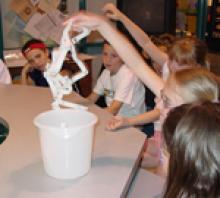
The goal of this demonstration is to show properties of polymers. Polymers are made from long chains of molecules called "monomers." What the monomers are made from and how they are arranged can change the properties of the polymer.
Six Pack Rings Procedure
Materials needed:
- Several store quality six-pack rings
- Photodegraded six-pack rings (six pack rings that have become brittle when exposed to UV light from the sun)
- Large plastic bag with a sealable top
- White Velcro strips with snaps on the ends (soft, "fuzz" side)
Procedure
Set-up:
- Define the word polymer as a long chain of molecules. Tell that that this long-chained molecule is a molecule that repeats itself. If there is more than one visitor present, have them link arms and tell them that by linking themselves together, they went from being monomers to a polymer chain.
- Hand out the white Velcro strips with snaps on the end and ask the museum guests to make polymers from the Velcro strips.
The Demonstration:
- Show the visitors the store quality six pack rings. Ask the visitors' questions about the six pack rings such as what do they look like? What are they made from? Is it a plastic? What is a plastic? What happens when you bend or fold the six pack rings?
- Ask for a volunteer to stretch the plastic ring apart and try to break it. While they are stretching it, point out that it is not easy to break the six pack rings because the polymer chains are tough and holding the shape of the six pack rings.
- When the six pack ring is broken, you may actually see "strings" of plastic. These "strings" are actually the chains of plastic molecules. (Plastics are polymers). All of the "strings" hold together to make the finished plastic to hold soda, water, etc. together.
- Because the six pack ring is tough to break, ask the visitors to think about why this could be bad? Have they ever seen pictures of animals caught in six-pack rings? Also, have they ever seen six-pack rings as litter?
- Finally, take the photodegraded six-pack rings and show them to the visitors. Ask them to notice differences between the two types of six-pack rings. Ask one of the visitors to try to break the rings, it should snap easily. Explain that ultraviolet light in sunlight breaks some of the bonds in the polymer chain. This allows the chains to fall apart easier and the six-pack rings to break! Every six-pack ring made in the United States since 1988 is photodegradeable.
Cleanup:
- Make sure the Nitinol is in its original shape. Use the blow dryer if it is not.
- Gather all materials and return to storage.
Procedure Sheet: sixpack_procedure.pdf
Six Pack Rings FAQs
The word polymer can be broken into two parts, "poly" means many and "mer" means parts. A polymer is a huge chain-like molecule made by combining many smaller parts. Six-Pack Rings are made from specific type of polymer referred to as a "plastic."
Cool Facts:
- Six pack rings are "photodegradable" meaning that they degrade, or break down, when exposed to light.
- Some polymers are made by people. Plastic is an example of a man-made or "synthetic" polymer. Some plastics can be recycled.
- Recycling is a series of activities that includes collecting recyclable materials that would otherwise be considered waste and making them into new products.
- Did you know that when a plastic is recycled, it is made into a new product? For example, a milk jug could be recycled into a picnic table or doghouse.
- The next time you fall asleep, you may be sleeping on what was once a soft-drink bottle. Sometimes, soft-drink bottles are recycled into pillow fillers!
A: The numbers that you see on plastic bottles are called "recycling codes." These symbols were designed in 1988 to allow recyclers to separate different types of plastics.
A: No, not all polymers are plastics but all plastics are polymers. Plastics are "synthetic polymers" which means they are man-made or not found in nature. There are many polymers found in nature which are called “natural polymers.” You may have a blouse made from silk which is a polymer that comes from the Silkworm. Also, proteins that you eat or drink such as fish or cow's milk are natural polymers.
A: Plastics have contributed much to society and technology. They have assisted space missions and improved medical treatments. At the same time, plastics accumulate in landfills. Recycling keeps plastics out of landfills.
A: Dr. Leo Baekeland invented the first man-made plastic in 1907. This same plastic that Leo Baekeland invented is still used as electric insulator today!
Plastics, which are made by polymers, are a large part of your everyday life! No matter your age, you rely on many plastics. Playing with plastic toys, watching television, playing video games, riding in car or bus and many other aspects of your daily life would not be possible without plastics.

